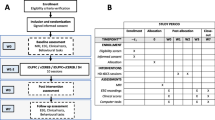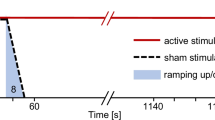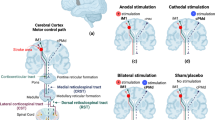Abstract
The beneficial effects of transcranial direct current stimulation (tDCS) for stroke rehabilitation are limited by the variability in changes in corticomotor excitability (CME) after tDCS. Neuronal activity is closely related to cerebral blood flow; however, the cerebral hemodynamics of neuromodulation in relation to neural effects have been less explored. In this study, we examined the effects of tDCS on cerebral blood velocity (CBv) in chronic stroke survivors using transcranial Doppler (TCD) ultrasound in relation to changes in CME and described the neurovascular characteristics of tDCS responders. Middle cerebral artery (MCA) CBv, cerebrovascular resistance (CVRi) and other cerebral hemodynamics-related variables were continuously measured before and after 15 min of 1 mA anodal tDCS to the lesioned lower limb M1. tDCS did not modulate CBv in the whole group and upon TMS-based stratification of responders and non-responders. However, at baseline, responders demonstrated lower CME levels, lower CBv and higher CVRi as compared to non-responders. These results indicate a possible difference in baseline CME and CBv in tDCS responders that may influence their response to neuromodulation. Future trials with a large sample size and repeated baseline measurements may help validate these findings and establish a relationship between neuromodulation and neurovascular mechanisms in stroke.




Similar content being viewed by others
Data accessibility
Deidentified data that support the findings of this study will be available on reasonable request from the corresponding author (S.M.) after completion of secondary analyses.
Abbreviations
- CME:
-
Corticomotor excitability
- CBF:
-
Cerebral blood flow
- CBv:
-
Cerebral blood velocity
- MBv:
-
Mean blood velocity
- CVRi:
-
Cerebrovascular resistance index
- PI:
-
Pulsatility index
- Et-CO2 :
-
End-tidal carbon dioxide
- tDCS:
-
Transcranial direct current stimulation
- TMS:
-
Transcranial magnetic stimulation
- MCA:
-
Middle cerebral artery
References
Aoi MC, Hu K, Lo M-T, Selim M, Olufsen MS, Novak V (2012) Impaired cerebral autoregulation is associated with brain atrophy and worse functional status in chronic ischemic stroke. PLoS One 7:e46794
Bazan R, Braga GP, Luvizutto GJ et al (2015) Evaluation of the temporal acoustic window for transcranial Doppler in a multi-ethnic population in Brazil. Ultrasound Med Biol 41:2131–2134. https://doi.org/10.1016/j.ultrasmedbio.2015.04.008
Boddington L, Reynolds J (2017) Targeting interhemispheric inhibition with neuromodulation to enhance stroke rehabilitation. Brain Stimul 10:214–222
Castro P, Azevedo E, Sorond F (2018) Cerebral autoregulation in stroke. Curr Atheroscler Rep 20:37. https://doi.org/10.1007/s11883-018-0739-5
Chang MC, Kim DY, Park DH (2015) Enhancement of cortical excitability and lower limb motor function in patients with stroke by transcranial direct current stimulation. Brain Stimul 8:561–566
Chew T, Ho KA, Loo CK (2015) Inter- and intra-individual variability in response to transcranial direct current stimulation (tDCS) at varying current intensities. Brain Stimul 8:1130–1137. https://doi.org/10.1016/j.brs.2015.07.031
Cipolla MJ (2009) The cerebral circulation. Morgan & Claypool Life Sciences, San Rafael, CA
Claassen JA, Meel-van den Abeelen AS, Simpson DM, Panerai RB, Network ICAR (2016) Transfer function analysis of dynamic cerebral autoregulation: a white paper from the International Cerebral Autoregulation Research Network. J Cereb Blood Flow Metab 36:665–680
De Berker AO, Bikson M, Bestmann S (2013) Predicting the behavioral impact of transcranial direct current stimulation: issues and limitations. Front Hum Neurosci 7:613
de Riva N, Budohoski KP, Smielewski P et al (2012) Transcranial Doppler pulsatility index: what it is and what it isn’t. Neurocrit Care 17:58–66
Devanathan D, Madhavan S (2016) Effects of anodal tDCS of the lower limb M1 on ankle reaction time in young adults. Exp Brain Res 234:377–385
Dissanayaka T, Zoghi M, Farrell M, Egan GF, Jaberzadeh S (2017) Does transcranial electrical stimulation enhance corticospinal excitability of the motor cortex in healthy individuals? A systematic review and meta-analysis. Eur J Neurosci 46:1968–1990. https://doi.org/10.1111/ejn.13640
Elting JW, Aries MJH, van der Hoeven JH, Vroomen PCAJ, Maurits NM (2014) Reproducibility and variability of dynamic cerebral autoregulation during passive cyclic leg raising. Med Eng Phys 36:585–591. https://doi.org/10.1016/j.medengphy.2013.09.012
Giordano J, Bikson M, Kappenman ES et al (2017) Mechanisms and effects of transcranial direct current stimulation. Dose Response 15:1559325816685467
Giorli E, Tognazzi S, Briscese L et al (2015) Transcranial direct current stimulation and cerebral vasomotor reserve: a study in healthy subjects. J Neuroimaging 25:571–574
Hennerici M, Rautenberg W, Sitzer G, Schwartz A (1987) Transcranial Doppler ultrasound for the assessment of intracranial arterial flow velocity—part 1. Examination technique and normal values. Surg Neurol 27:439–448
Ivey FM, Ryan AS, Hafer-Macko CE, Macko RF (2011) Improved cerebral vasomotor reactivity after exercise training in hemiparetic stroke survivors. Stroke 42:1994–2000
Iyer PC, Madhavan S (2018) Non-invasive brain stimulation in the modulation of cerebral blood flow after stroke: a systematic review of Transcranial Doppler studies. Clin Neurophysiol 129:2544–2551. https://doi.org/10.1016/j.clinph.2018.09.019
Jørgensen LG (1995) Transcranial Doppler ultrasound for cerebral perfusion. Acta Physiol Scand Suppl 625:1–44
Kamke MR, Hall MG, Lye HF et al (2012) Visual attentional load influences plasticity in the human motor cortex. J Neurosci 32:7001–7008
Kamke MR, Ryan AE, Sale MV, Campbell ME, Riek S, Carroll TJ, Mattingley JB (2014) Visual spatial attention has opposite effects on bidirectional plasticity in the human motor cortex. J Neurosci 34:1475–1480
Kang N, Summers JJ, Cauraugh JH (2015) Transcranial direct current stimulation facilitates motor learning post-stroke: a systematic review and meta-analysis. J Neurol Neurosurg Psychiatry 87:345–355
Kassab Mounzer Y, Majid Arshad, Farooq Muhammad U, Azhary Hend, Hershey Linda A, Bednarczyk Edward M, Graybeal Dion F, Johnson Mark D (2007) Transcranial Doppler: an introduction for primary care physicians. J Am Board Fam Med 20:65–71
Kontos HA (1989) Validity of cerebral arterial blood flow calculations from velocity measurements. Stroke 20:1–3
Krainik A, Hund-Georgiadis M, Zysset S, Von Cramon DY (2005) Regional impairment of cerebrovascular reactivity and BOLD signal in adults after stroke. Stroke 36:1146–1152
Krakauskaite S, Thibeault C, LaVangie J et al. (2018) Normative ranges of transcranial doppler metrics. In: Heldt T (ed) Intracranial pressure & neuromonitoring XVI. Springer, Berlin, pp 269–273
Krejza J, Swiat M, Pawlak MA, Oszkinis G, Weigele J, Hurst RW, Kasner S (2007) Suitability of temporal bone acoustic window: conventional TCD versus transcranial color-coded duplex sonography. J Neuroimaging 17:311–314. https://doi.org/10.1111/j.1552-6569.2007.00117.x
Labruna L, Jamil A, Fresnoza S et al (2016) Efficacy of anodal transcranial direct current stimulation is related to sensitivity to transcranial magnetic stimulation. Brain Stimul 9:8–15
Lang N, Siebner HR, Ward NS et al (2005) How does transcranial DC stimulation of the primary motor cortex alter regional neuronal activity in the human brain? Eur J Neurosci 22:495–504
Lecrux C, Hamel E (2011) The neurovascular unit in brain function and disease. Acta Physiol 203:47–59
Li LM, Uehara K, Hanakawa T (2015) The contribution of interindividual factors to variability of response in transcranial direct current stimulation studies. Front Cell Neurosci. https://doi.org/10.3389/fncel.2015.00181
Liew S-L, Anglin JM, Banks NW et al (2017) The anatomical tracings of lesions after stroke (ATLAS) dataset—release 1.1. bioRxiv: 179614. https://doi.org/10.1101/179614
Lin W, Hao Q, Rosengarten B, Leung W, Wong K (2011) Impaired neurovascular coupling in ischaemic stroke patients with large or small vessel disease. Eur J Neurol 18:731–736
List J, Lesemann A, Kubke JC, Kulzow N, Schreiber SJ, Floel A (2015) Impact of tDCS on cerebral autoregulation in aging and in patients with cerebrovascular diseases. Neurology 84:626–628. https://doi.org/10.1212/wnl.0000000000001230
López-Alonso V, Cheeran B, Río-Rodríguez D, Fernández-del-Olmo M (2014) Inter-individual variability in response to non-invasive brain stimulation paradigms. Brain Stimul Basic Transl Clin Res Neuromodul 7:372–380. https://doi.org/10.1016/j.brs.2014.02.004
Madhavan S, Stinear JW (2010) Focal and bidirectional modulation of lower limb motor cortex using anodal transcranial direct current stimulation. Brain Stimul 3:42–50. https://doi.org/10.1016/j.brs.2009.06.005
Madhavan S, Weber KA, Stinear JW (2011) Non-invasive brain stimulation enhances fine motor control of the hemiparetic ankle: implications for rehabilitation. Exp Brain Res 209:9–17. https://doi.org/10.1007/s00221-010-2511-0
Madhavan S, Sriraman A, Freels S (2016a) Reliability and variability of tDCS induced changes in the lower limb motor cortex. Brain Sci 6:26
Madhavan S, Stinear JW, Kanekar N (2016b) Effects of a single session of high intensity interval treadmill training on corticomotor excitability following stroke: implications for therapy. Neural Plast 2016:8. https://doi.org/10.1155/2016/1686414
Maeda H, Matsumoto M, Handa N et al (1993) Reactivity of cerebral blood flow to carbon dioxide in various types of ischemic cerebrovascular disease: evaluation by the transcranial Doppler method. Stroke 24:670–675
Matteis M, Caltagirone C, Troisi E, Vernieri F, Monaldo BC, Silvestrini M (2001) Changes in cerebral blood flow induced by passive and active elbow and hand movements. J Neurol 248:104–108. https://doi.org/10.1007/s004150170243
Matteis M, Vernieri F, Troisi E, Pasqualetti P, Tibuzzi F, Caltagirone C, Silvestrini M (2003) Early cerebral hemodynamic changes during passive movements and motor recovery after stroke. J Neurol 250:810–817. https://doi.org/10.1007/s00415-003-1082-4
McSwain SD, Hamel DS, Smith PB, Gentile MA, Srinivasan S, Meliones JN, Cheifetz IM (2010) End-tidal and arterial carbon dioxide measurements correlate across all levels of physiologic dead space. Respir Care 55:288–293
Merzagora AC, Foffani G, Panyavin I, Mordillo-Mateos L, Aguilar J, Onaral B, Oliviero A (2010) Prefrontal hemodynamic changes produced by anodal direct current stimulation. Neuroimage 49:2304–2310
Muoio V, Persson P, Sendeski M (2014) The neurovascular unit—concept review. Acta Physiol 210:790–798
Nord C, Lally N, Charpentier C (2013) Harnessing electric potential: DLPFC tDCS induces widespread brain perfusion changes. Front Syst Neurosci 7:99
Nowak-Flück D, Ainslie PN, Bain AR et al (2018) Effect of healthy ageing on cerebral blood flow, CO2 reactivity and neurovascular coupling during exercise. J Appl Physiol 125:1917–1930
O’rourke MF, Hashimoto J (2007) Mechanical factors in arterial aging: a clinical perspective. J Am Coll Cardiol 50:1–13
Parton A, Malhotra P, Husain M (2004) Hemispatial neglect. J Neurol Neurosurg Psychiatry 75:13–21
Payne S (2016) Cerebral autoregulation: control of blood flow in the brain. Springer, Berlin
Perry BG, Schlader ZJ, Barnes MJ, Cochrane DJ, Lucas S, MüNDEL T (2014) Hemodynamic response to upright resistance exercise: effect of load and repetition. Med Sci Sports Exerc 46:479–487
Puri R, Hinder MR, Fujiyama H, Gomez R, Carson RG, Summers JJ (2015) Duration-dependent effects of the BDNF Val66Met polymorphism on anodal tDCS induced motor cortex plasticity in older adults: a group and individual perspective. Front Aging Neurosci 7:107
Purkayastha S, Sorond F (2012) Transcranial Doppler ultrasound: technique and application. Semin Neurol 32:411–420. https://doi.org/10.1055/s-0032-1331812
Rosengarten B, Huwendiek O, Kaps M (2001) Neurovascular coupling and cerebral autoregulation can be described in terms of a control system. Ultrasound Med Biol 27:189–193
Salinet ASM, Panerai RB, Robinson TG (2012) Effects of active, passive and motor imagery paradigms on cerebral and peripheral hemodynamics in older volunteers: a functional TCD study. Ultrasound Med Biol 38:997–1003. https://doi.org/10.1016/j.ultrasmedbio.2012.02.016
Salinet AS, Haunton VJ, Panerai RB, Robinson TG (2013) A systematic review of cerebral hemodynamic responses to neural activation following stroke. J Neurol 260:2715–2721
Sivaramakrishnan A, Madhavan S (2018) Absence of a transcranial magnetic stimulation-induced lower limb corticomotor response does not affect walking speed in chronic stroke survivors. Stroke 49(8):2004–2007
Sivaramakrishnan A, Tahara-Eckl L, Madhavan S (2016) Spatial localization and distribution of the TMS-related ‘hotspot’of the tibialis anterior muscle representation in the healthy and post-stroke motor cortex. Neurosci Lett 627:30–35
Smirl JD, Tzeng Y-C, Monteleone BJ, Ainslie PN (2014) Influence of cerebrovascular resistance on the dynamic relationship between blood pressure and cerebral blood flow in humans. J Appl Physiol 116:1614–1622
Sohn MK, Jee SJ, Kim YW (2013) Effect of transcranial direct current stimulation on postural stability and lower extremity strength in hemiplegic stroke patients. Ann Rehabil Med 37:759–765. https://doi.org/10.5535/arm.2013.37.6.759
Sriraman A, Oishi T, Madhavan S (2014) Timing-dependent priming effects of tDCS on ankle motor skill learning. Brain Res 1581:23–29. https://doi.org/10.1016/j.brainres.2014.07.021
Stagg CJ, Nitsche MA (2011) Physiological basis of transcranial direct current stimulation. Neuroscientist 17:37–53
Stagg CJ, Lin RL, Mezue M, Segerdahl A, Kong Y, Xie J, Tracey I (2013) Widespread modulation of cerebral perfusion induced during and after transcranial direct current stimulation applied to the left dorsolateral prefrontal cortex. J Neurosci 33:11425–11431
Strube W, Bunse T, Malchow B, Hasan A (2015) Efficacy and interindividual variability in motor-cortex plasticity following anodal tDCS and paired-associative stimulation. Neural Plast 2015:530423
Strube W, Bunse T, Nitsche MA et al (2016) Bidirectional variability in motor cortex excitability modulation following 1 mA transcranial direct current stimulation in healthy participants. Physiol Rep 4:e12884
Suri MFK, Georgiadis AL, Tariq N, Vazquez G, Qureshi N, Qureshi AI (2011) Estimated prevalence of acoustic cranial windows and intracranial stenosis in the US elderly population: ultrasound screening in adults for intracranial disease study. Neuroepidemiology 37:64–71. https://doi.org/10.1159/000327757
Tanaka S, Hanakawa T, Honda M, Watanabe K (2009) Enhancement of pinch force in the lower leg by anodal transcranial direct current stimulation. Exp Brain Res 196:459–465
Tanaka S, Takeda K, Otaka Y et al (2011) Single session of transcranial direct current stimulation transiently increases knee extensor force in patients with hemiparetic stroke. Neurorehabil Neural Repair 25:565–569
Tegeler CH, Crutchfield K, Katsnelson M et al (2013) Transcranial Doppler velocities in a large, healthy population. J Neuroimaging 23:466–472
Tremblay S, Larochelle-Brunet F, Lafleur LP, El Mouderrib S, Lepage JF, Théoret H (2016) Systematic assessment of duration and intensity of anodal transcranial direct current stimulation on primary motor cortex excitability. Eur J Neurosci 44:2184–2190
Ugur HC, Kahilogullari G, Coscarella E et al (2005) Arterial vascularization of primary motor cortex (precentral gyrus). Surg Neurol 64:S48–S52. https://doi.org/10.1016/j.surneu.2005.07.049
van Beek AH, Claassen JA, Rikkert MGO, Jansen RW (2008) Cerebral autoregulation: an overview of current concepts and methodology with special focus on the elderly. J Cereb Blood Flow Metab 28:1071–1085. https://doi.org/10.1038/jcbfm.2008.13
Vernieri F, Assenza G, Maggio P et al (2010) Cortical neuromodulation modifies cerebral vasomotor reactivity. Stroke 41:2087–2090. https://doi.org/10.1161/strokeaha.110.583088
Wiethoff S, Hamada M, Rothwell JC (2014) Variability in response to transcranial direct current stimulation of the motor cortex. Brain Stimul 7:468–475. https://doi.org/10.1016/j.brs.2014.02.003
Williams CAL, Panerai RB, Robinson TG, Haunton VJ (2017) Transcranial Doppler ultrasonography in the assessment of neurovascular coupling responses to cognitive examination in healthy controls: a feasibility study. J Neurosci Methods 284:57–62. https://doi.org/10.1016/j.jneumeth.2017.04.013
Willie CK, Colino FL, Bailey DM et al (2011) Utility of transcranial Doppler ultrasound for the integrative assessment of cerebrovascular function. J Neurosci Methods 196:221–237. https://doi.org/10.1016/j.jneumeth.2011.01.011
Zheng X, Alsop DC, Schlaug G (2011) Effects of transcranial direct current stimulation (tDCS) on human regional cerebral blood flow. Neuroimage 58:26–33
Ziemann U, Siebner HR (2008) Modifying motor learning through gating and homeostatic metaplasticity. Brain Stimul 1:60–66. https://doi.org/10.1016/j.brs.2007.08.003
Acknowledgements
We would like to thank the members of Brain Plasticity Lab. This work was partly supported by a grant funded by the National Institute of Health (NIH) R01HD075777 (SM).
Author information
Authors and Affiliations
Corresponding author
Ethics declarations
Conflict of interest
The authors declare that they have no conflict of interest.
Additional information
Publisher's Note
Springer Nature remains neutral with regard to jurisdictional claims in published maps and institutional affiliations.
Rights and permissions
About this article
Cite this article
Iyer, P.C., Rosenberg, A., Baynard, T. et al. Influence of neurovascular mechanisms on response to tDCS: an exploratory study. Exp Brain Res 237, 2829–2840 (2019). https://doi.org/10.1007/s00221-019-05626-8
Received:
Accepted:
Published:
Issue Date:
DOI: https://doi.org/10.1007/s00221-019-05626-8




